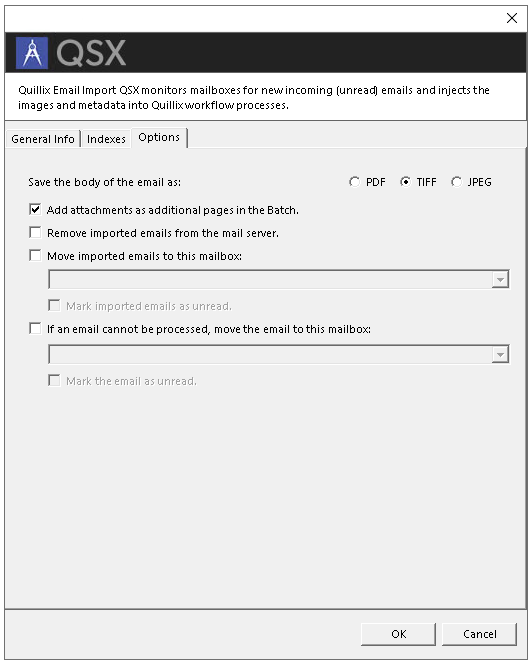
The Email Import QSX is a Quillix Input QSX that a Quillix Server can use to capture emails and attachments. The QSX creates a new batch out of each imported email, and sets Batch Profile Index Fields to the selected metadata.
The QSX Configuration Dialog provides settings for General Info, Indexes and other options. The QSX Configuration Dialog is accessed by either double-clicking on an instance of the QSX, or by right clicking on an instance of the QSX on a capture process map, and clicking on Configure.
The first tab on the QSX Configuration Dialog is used mostly to provide connection information for the Email provider. There are additional options for setting the Mailbox, Temporary Directory and to enable Verbose Logging.

Figure 1 - Email Import QSX - General Info
|
Email Address |
Provide the address to be monitored. |
|
Password |
Provide the password required to log in with the Email Address listed above. |
|
Incoming Email Server |
Provide the address of an IMAP or POP server. |
|
Account Type |
Allows selecting either IMAP or POP. |
|
Connect button |
Connects the QSX using the configured server settings. If IMAP is set, also returns a list of mailboxes that can be used. |
|
Mailbox |
IMAP setting. Tells the QSX what mailbox should be monitored. |
|
Temporary Directory |
Tells the QSX where to write temporary files. |
|
Verbose Logging |
Sends all tracing of the QSX to the Quillix Capture Report log. This is the same tracing normally seen only when the TraceFile registry entry is enabled. |
The second tab on the QSX Configuration Dialog is used to set the Quillix Batch Profile and to map Batch Profile Index Fields to the email metadata.

Figure 2 - Email Import QSX - Indexes
|
Quillix Profile |
Sets the Batch Profile to be used when importing emails. The Batch Profile Index Fields used for assigning metadata come from this Batch Profile. |
|
Monitored Email Address, etc. |
This setting and the ones that follow tell the QSX to write the metadata retrieved from the email to the selected Batch Profile Index Field. |
|
To, CC, and BCC Addresses list delimiter |
Tells the QSX what character to use as a delimiter between each address read from the email. |
The third tab on the QSX Configuration Dialog is used to set additional options for the QSX.

Figure 2 - Email Import QSX - Options
|
Save the body of the email as |
Tells the QSX the file format in which to store the body of the email. The body is stored as a page in the batch, either as a PDF, TIFF, or JPEG file. |
|
Add attachments as additional pages in the Batch |
Tells the QSX to add the email's attachments as additional pages in the batch. |
|
Remove imported emails from the mail server |
Tells the QSX to delete imported emails rather than only marking them as read. |
|
Move imported emails to this mailbox |
Tells the QSX to move imported emails to a separate mailbox. This enables an additional option to mark the email as unread. |
|
If an email cannot be processed, move the email to this mailbox. |
Tells the QSX what to do with emails it cannot import. This enables an additional option to mark the email as unread. |